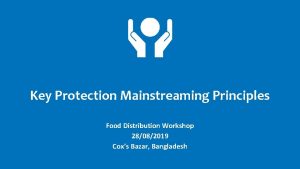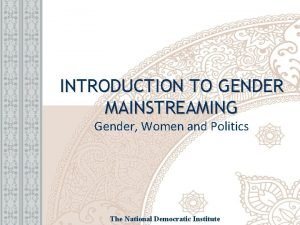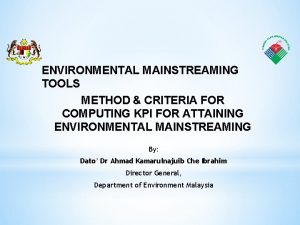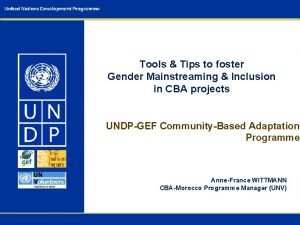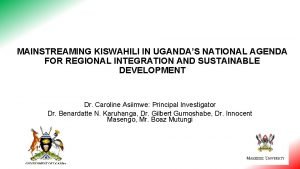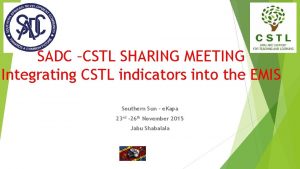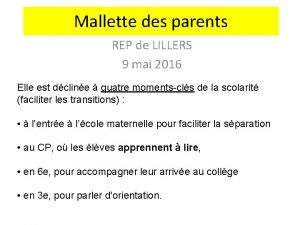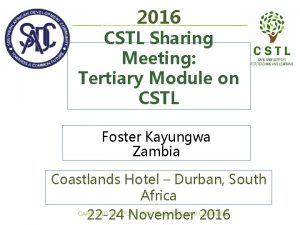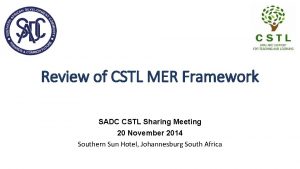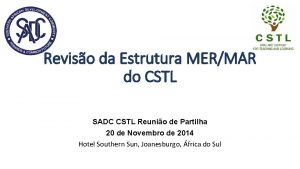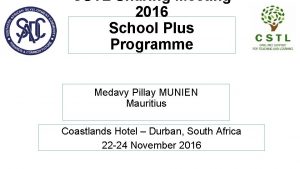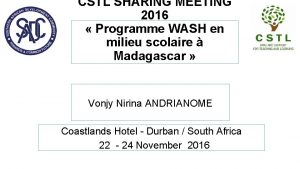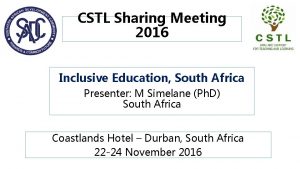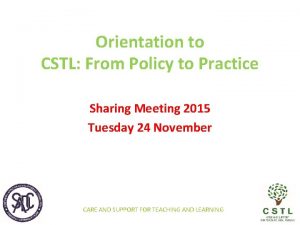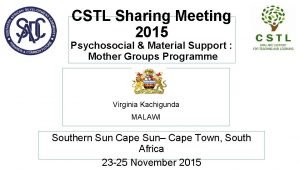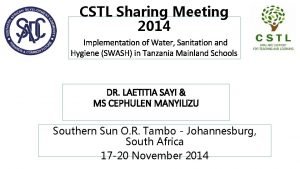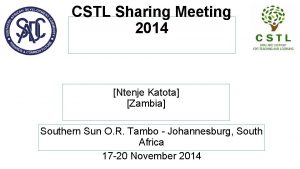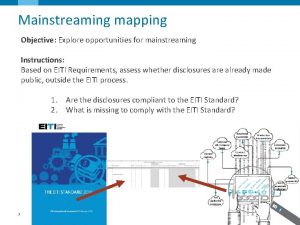CSTL Sharing Meeting 2016 Mainstreaming CSTL through Policy


















- Slides: 18

CSTL Sharing Meeting 2016 Mainstreaming CSTL through Policy and Advocacy C. C. Kateera Zimbabwe Coastlands Hotel – Durban, South Africa 22 -24 November 2016

Background To The CSTL Programme in Zimbabwe • Zimbabwe joined the CSTL family in 2014 with preparatory activities to start the programme commencing in 2015 through the selection and preassessment of the 15 pilot schools to determine how CSTL compliant they were. For Zimbabwe CSTL was not a new programme as the country had been implementing The Child Friendly Schools programme as well as programmes such as Learning Without Fear, which were all aimed at creating a conducive learning environment. CSTL thus came as one of those programmes aimed at improving the welfare of the child, especially vulnerable children.

Background (contd) • Zimbabwe has a very large number of schools (8751). A pilot of just fifteen (15) schools in this huge mass would therefore make the programme quite inconsequential. As a country we had to come up with a strategy that would see the programme making an impact and meaning to a wider population of our education system. This has been done through a series and variety of activities and programmes.

Establishment of Structures • For the programme to be better understood and implemented, it was found necessary to establish structures that would facilitate such implementation. • Advocacy was first done with Senior Management personnel culminating in the establishment of a national level structure, the National Technical Education Working Group (NTEWG) • The next level structure is the Provincial Technical Education Working Group (PTEWG), a replica of the national level structure in both composition and functions in each of the ten provinces in the country. • The District Technical Education Working Group (DTEWG) is based at the district level of our structures and also composed in similar fashion as the other two levels above it.

Establishment of Structures (contd) • At school level is the final and most critical of the structures as far as programme implementation is concerned, the School Development Committee (SDC), as it is at the level where the child is generally always present. • Let it be pointed out that these structures have always been in existence and that it was found prudent to use them for the implementation of CSTL as one of the many other programmes.

Mainstreaming CSTL Through Policy Harmonization • Zimbabwe has a number of policy documents and policies that speak to CSTL and thus enable ease of implementation of the programme. • The Constitution of Zimbabwe 2013, has it enshrined in Chapter 4 section 81 that spells out the Rights of Children and thus acts as the guiding principle in the implementation of CSTL since it is the supreme law of the land. • We are at an advanced stage in trying to align the Education Act to our New Constitution and other related policy documents so that they too speak to the

Sensitization on CSTL The Regional Coordinator for Zimbabwe and Swaziland stresses a point during one of the many trainings that she conducted in Zimbabwe.

CSTL Advocacy Activities • As mentioned earlier on, Zimbabwe realised that due to the size of the country and due to the fact that CSTL is not an entirely new programme, it was important to pilot and at the same time scale up the programme as the necessary structures already exist within our education system. • Funds that were aimed to do activities in the laboratory schools have since been stretched to cover a larger population of the schools. Through the Cluster Schools concept CSTL has been taken to more schools. • For example funds earmarked for the induction of teachers at the laboratory school benefitted more teachers through the cluster trainings. Representatives were drawn from each of the schools in the cluster. After the trainer of trainers workshop, these representatives went back to train teachers in their schools.

Advocacy Preparations The Master Trainer and Regional Coordinator prepare the venue in readiness for the workshop.

CSTL Advocacy Activities (cont’d) • A total of (350) teachers were thus trained as trainers of trainers. These teachers then went back and reached out to over (2 000) more teachers in schools within their clusters. • For the CSTL programme to succeed, there is need for massive resource mobilisation. At school level the community is responsible for resource provision and mobilisation. It was therefore found prudent to include chairpersons of the School Development Committees in the induction of teachers workshops. This assisted the heads of schools when it came to presenting the programme to the parents as they then used the chairpersons to explain it to the

Inducting Stakeholders Teachers at Mudadisi Primary School follow Proceedings during a CSTL Induction Workshop.

Advocacy Through The Training of District Schools Inspectors. • In a bid to both pilot and scale up the CSTL programme at the same time, the Steering Committee found it necessary to train all the District Schools Inspectors in the country. • District Schools Inspectors are at the implementation level of our education system. They are in regular contact with heads of schools hence have a greater influence and impact on the school system. • After the DSI’s trainings, an Action Plan was drawn where the DSIs would go back and train all the heads in their districts. The heads would then go on to train teachers and members of the SDCs and thus spread the CSTL gospel even wider to both learners and parents.

Advocacy Through Training of DSIs (cont’d) • In addition, DSIs would also hold induction workshops for stakeholders at District level. DSIs were advised to work with the office of the District Administrator in a bid to reach out to more stakeholders. • Some districts have already submitted positive responses to this initiative.

Advocacy through Parenting Skills Workshops • In order for parents to fully understand their roles in the education and upbringing of their children it was found essential to first give them a brief overview of CSTL. • In order to provide for greater advocacy, the community leadership by way of traditional leaders, counsellors and all other stakeholders working with the schools were involved in the training.

Parent workshop at Munkula Primary Matabeleland south

Advocacy Using Various Fora • Like in the Parenting Skills workshops, a number of other fora were used to advocate CSTL such as World Environment Day celebrations, whose theme was the conservation of nature: ‘Go Wild For Life. Save The Environment, and the Jamboree/ Service Fair at Shurugwi 2 High School. • All in all any occasion that brings people together was used as an opportunity to do advocacy on CSTL. • The involvement of learners, facilitated for greater advocacy amongst both learners and parents.

Jamboree at Shurugwi 2 High School.

Conclusion • As Zimbabwe we believe we are no longer at pilot stage but that we have managed to pilot and at the same time scale up the programme. • I THANK YOU!
 Protection mainstreaming principles
Protection mainstreaming principles What is gender mainstreaming?
What is gender mainstreaming? What is gender mainstreaming?
What is gender mainstreaming? Ercmc organization chart
Ercmc organization chart Gender mainstreaming
Gender mainstreaming Gender mainstreaming
Gender mainstreaming Mainstreaming in swahili
Mainstreaming in swahili Cstl pillars
Cstl pillars Moodle cstl
Moodle cstl Cstl calendrier
Cstl calendrier Diverse information sharing through universal web access
Diverse information sharing through universal web access Introduction for ict
Introduction for ict Nrg oncology meeting 2019
Nrg oncology meeting 2019 Nrg oncology semiannual meeting 2021
Nrg oncology semiannual meeting 2021 Nrg oncology meeting 2016
Nrg oncology meeting 2016 Housing opportunity through modernization act of 2016
Housing opportunity through modernization act of 2016 For today's meeting
For today's meeting Meeting objective
Meeting objective What is meeting and types of meeting
What is meeting and types of meeting
